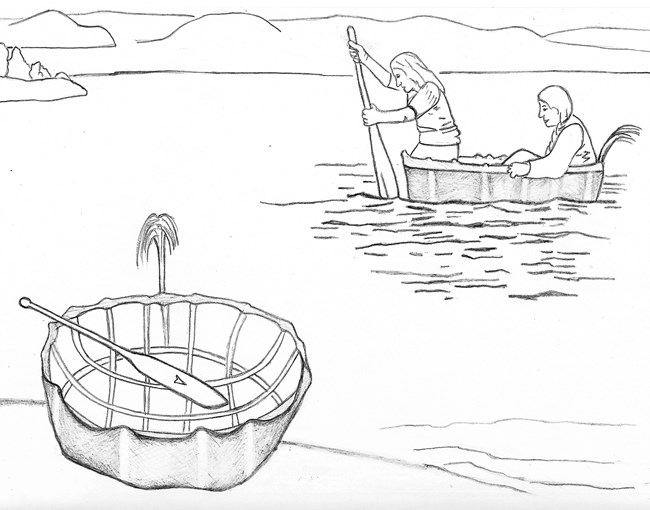Last updated: April 14, 2025
Article
Bull Boats During the Fur Trade

NPS Graphic / G.M. Spoto
Bull Boats
Commonly associated with the Mandan, Hidatsa, and Arikara, bull boats were necessary to cross rivers in the West. They transported loads of meat and firewood up and down rivers. These light vessels could drift as much as a mile during the crossing! Hair side facing out helped keep boats from spinning, and a tail served as an attachment point for towing. Weighing as little as thirty pounds and made from the hide of bison, they replaced canoes west of Grand Portage in a landscape where birch was scarce. A willow frame covered with fresh hide could be built in a day. The paddles were made from cottonwood, sometimes with a bison shoulder blade. Bull boats need to dry out periodically to prevent them from becoming waterlogged.
The North West Company Traveled by Water
In 1774, prior to the forming of the North West Company, future partner Peter Pond notes Dakota along the Riviere St. Pierre (St. Peter or Minnesota River), making and using these boats. Alexander Henry, the 1801 company partner on the Red River (Minnesota and North Dakota border), mentions hair-on-hide boats. Trader Archibald McLeod, working west of Lake Winnipeg for the North West Company in 1801, writes of obtaining enough bison hides to make what he refers to as canoes.
The Larger Role of Bison in the Fur Trade
Bull boats were far from being the only use of bison in the fur trade. Without a question, pemmican was the most vital. Pemmican is made from dried, pounded bison meat mixed with melted grease and dried berries (when available). The North West Company’s employees consumed thousands of pounds of this food staple in the interior. The company established several trading posts in “buffalo country” for the sole purpose of pemmican production and/or procurement from local Indigenous groups. Bison fat also was an ingredient of tallow candles at trading posts. Bison pelts created thick warm robes and often bedding, and the leather made tugs or cordage. Some hides wrapped fur bales, protecting more valuable furs such as beaver or marten.
